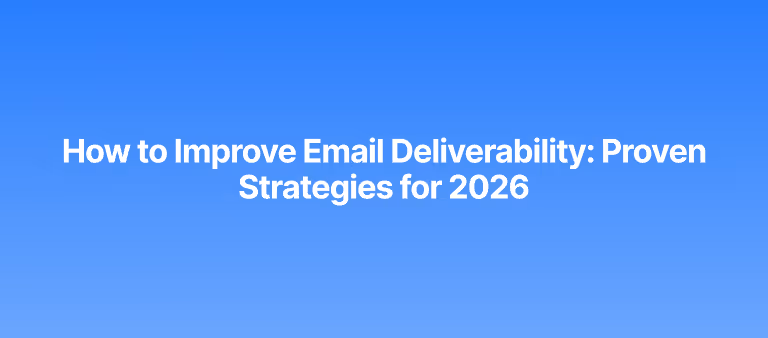Outbound Lead Generation That Works: A Complete Guide [2025 Updated]
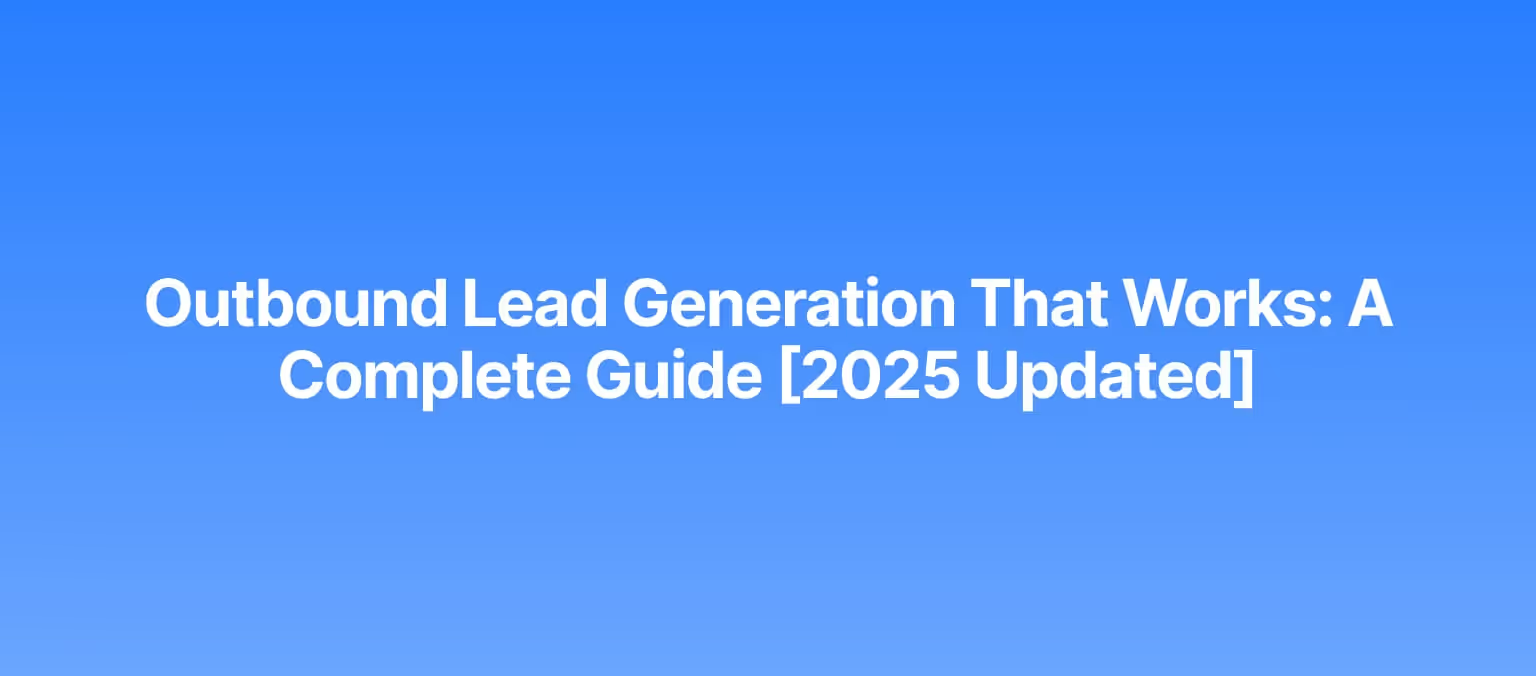
Table of content
Share article
Every business needs a steady stream of qualified leads to sustain revenue growth, and in today’s increasingly crowded markets, inbound alone will only get you so far.
That’s where outbound lead generation comes into play. Instead of waiting for prospects to make the first move, outbound lets you take action and create opportunities on demand.
The problem is that outbound has become much harder over the years. Buyers are drowning in sales messages, inbox filters are stricter than ever, and the old “spray and pray” approach is long gone.
To succeed in 2025, outbound lead generation must be built like a full-on system — structured, data-driven, and automated enough to scale while still building real connections with the right buyers.
This guide lays out exactly how to do that, along with the strategies, frameworks, and tools that top teams are using to turn outbound into a repeatable growth engine.
What is outbound lead generation?
When it comes to generating leads, outbound simply means you’re the one who makes the first move. Instead of waiting for potential buyers to click an ad, find a blog post, or join a webinar, you reach out directly to them and start the conversation.
That’s especially important in B2B, where buying cycles are often long and complex, with multiple stakeholders weighing in on decisions, all while budgets and priorities shift rapidly.
Outbound gives you control amid the chaos. You put your offer in front of the right people at the right moment (and timing matters just as much), rather than hoping they eventually come across your product or service on their own.
At its core, outbound has two key parts: finding the right leads and building meaningful connections with them. Each part hides several moving sub-layers, such as data quality, timing, intent signals, channel mix, and automated touchpoints, just to name a few.
That’s why solid outbound systems avoid single-channel or linear workflows. They pull data from multiple sources (e.g., lead databases, enrichment tools, and LinkedIn signals), and engage prospects through multiple touchpoints across different channels, most notably — email, LinkedIn, messengers, and calls.
When these pieces are properly connected, data flows smoothly across the system, outreach feels natural, and leads naturally move through the pipeline without any friction.
What is the outbound lead generation process?
Think of outbound lead generation as a chain of interconnected steps. Skip one, and the whole system weakens. Done right, it’s a structured and scalable process that runs like clockwork, turning raw data into booked meetings. Here’s how it usually plays out:
- Research and list building. Everything starts with defining your ICP and finding the right people. Most companies rely on LinkedIn and lead databases to find targeted decision-makers. They then verify all emails, enrich those profiles with additional data like firmographics, job changes, or tech stack info, and set custom triggers to monitor any new intent signals, all of which will be very useful in outreach.
- Crafting targeted messages. Once the list is set and trigger alerts are in place, ready to notify teams of any new opportunities, the focus shifts to outreach. Good outbound emails are tailored directly to the role and/or pain point of the prospect. Besides personalization, providing true value within each touchpoint is among the most important cold email best practices out there. As Michel Lieben, Founder & CEO of ColdIQ, puts it:
“You’re interrupting people’s days by sending unsolicited messages. Providing value or real insights is the fastest way to build trust. One way I like to do it: reflect on what I’d do first after signing a prospect, do it already, and give it away for free.”
- Outreach across chosen channels. Email remains the backbone of all business communication, but outreach is rarely single-threaded anymore, especially in B2B. Modern sales teams set up multi-touch flows to get better engagement rates, and outreach software automates the whole thing (e.g., Day 1: email, Day 3: LinkedIn connection request, Day 5: LinkedIn message).
- Follow-ups and tracking. Most sales teams start seeing replies after the 2nd, 3rd, or even 5th touch. That’s why follow-ups are not only optimized for sparking a response (short, personalized, value-driven), but also pre-scheduled and sent out automatically. Just like with the initial messages, analytics help identify which follow-up messages & subject lines work best to double down on them.
- Qualifying leads and handoff to sales. With the following process, replies will start coming in swiftly, but the final step is to turn them into actual opportunities. Each engaged lead is checked against your ICP, and only those showing clear buying intent are handed over to sales reps, while the rest remain in automated nurturing campaigns.
AI & automation in outbound
You can do everything in outbound manually, but it's almost impossible to scale without outbound sales automation.
The good news is that AI software is now available to even small businesses and startups in 2025, and it has changed both sides of the B2B outbound lead generation equation:
- On the prospecting and intelligence side, AI keeps prospect lists accurate and complete by continuously enriching each profile with live context like funding announcements, hiring trends, tech adoption, and so on.
- On the personalization and outreach side, AI uses that data and those triggers to customize messages and timing, ensuring that each lead gets highly relevant email or LinkedIn messages, at a time when they are most likely to engage.
Teams also need software to handle cold email deliverability to make sure that messages actually reach their recipients while domains stay protected in the long run.
The real benefit, and challenge, is connecting these tools together to create a unified automation engine that lets data flow smoothly from research to outreach to booked meetings.
Here’s an example of an outbound sales stack for teams starting from scratch, built with our top tested tools:
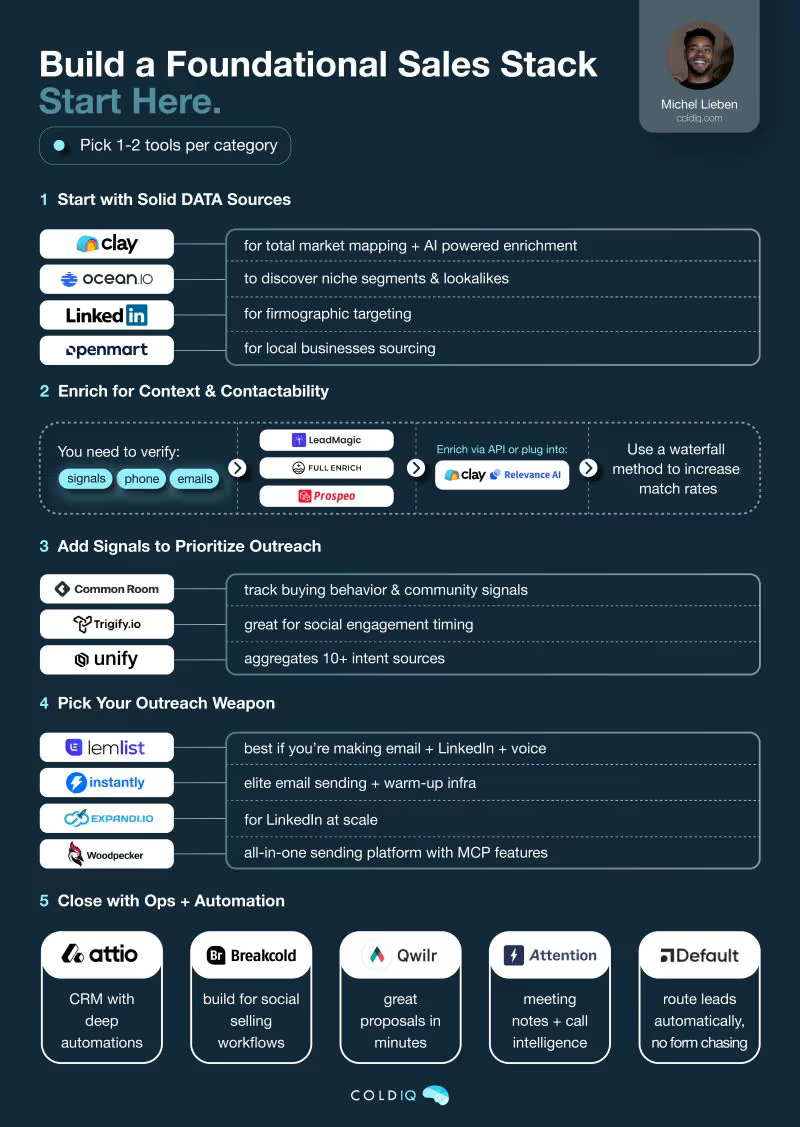
What are outbound lead generation services?
Looking at the process above, it’s clear that B2B outbound lead generation is far from simple. It’s a full-on system — part strategy, part infrastructure — that most internal teams simply don’t have the time or expertise to set up on their own.
Each step that we discussed has its own landmines, and stitching them all together is even harder. Besides, sales reps would have to shadow as deliverability engineers and automation experts instead of solely focusing on meetings and closing deals.
That’s why more and more companies are turning to experts with proven success in outbound lead generation services.
Specialized agencies like ColdIQ know exactly how to build functional outbound lead generation systems, manage the entire technical setup, and run campaigns that keep leads flowing.
Outsourcing usually wins on speed and consistency: an agency can get you from zero to live campaigns in weeks, not months. And while in-house may give you more control over the entire process, it comes at the cost of headcount, time, and constant firefighting.
What are the top outbound lead generation strategies?
Outbound works when the system is tight — you’re hitting the right people, with the right message, on the right channel, at the right time. Below are the core outbound lead generation strategies that consistently drive results in B2B when executed properly.
AI-powered prospecting
The foundation of B2B outbound lead generation is the pipeline itself. In the past, that meant buying static lists, blasting untargeted mass outreach, or hand-picking potential buyers. Today, teams that leverage AI for sales prospecting generate leads faster and infinitely more precisely.
It all starts with your ICP: industry, size, geography, tech stack, and buying roles. But instead of manually stitching lists together, AI prospecting platforms now pull prospect information from multiple sources at once, most notably — lead databases, LinkedIn, and company news, and then combine them into unified lead profiles.
To put this in practice, you could start with a prospecting tool like Instantly or LinkedIn Sales Navigator to source contacts, and then integrate Clay to enrich all their profiles with additional, more high-level data like funding rounds, tech adoption, and so on.
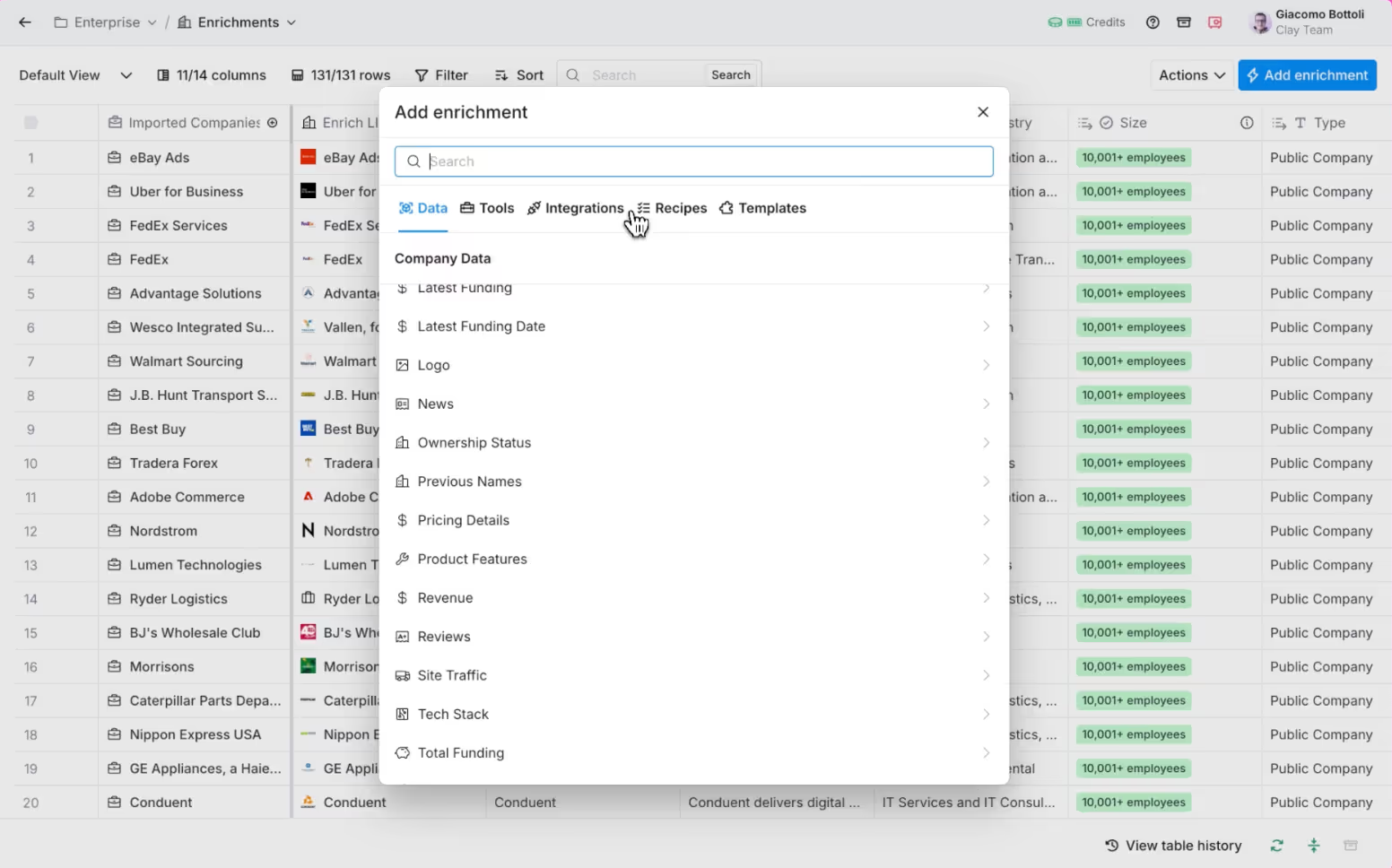
Clay will also automatically verify and clean all data, so all leads that land in your CRM or outreach platform are complete, reliable, and ready for engagement.
Another great advantage of AI prospecting is its ability to intelligently prioritize leads. AI can automatically score all new leads against your ICP and other set criteria, and flag which accounts are most likely to engage.
Instead of treating every contact equally, your reps focus their efforts on those that are most likely to convert into buyers, based on concrete data. The result is a pipeline that’s cleaner, more targeted, and ready for action before the first touch.
Intent data & buyer signal targeting
Nowadays, having a clean list with relevant prospects isn’t enough. The next question becomes: when do you reach out?
Back in the day, many experts agreed that Tuesday at 8am was the “best” time. But today, the best time to reach out is when each individual prospect is showing intent.
Intent data captures company-level triggers, and it could be anything from a funding announcement to a sudden wave of new hires.
Buyer signals go even deeper at the individual level. A decision-maker posting about a relevant challenge on LinkedIn or engaging with pain-focused content are just a few great sales triggers to find clients who are ready to talk about solutions.
This too can, and should, be automated. For example, a cybersecurity firm uses Clay to monitor funding announcements by their target accounts. The moment a Series B round is detected, the platform will automatically queue this lead into a relevant outbound sequence, and reps get notified with enriched context to start outreach right away, as shown below:
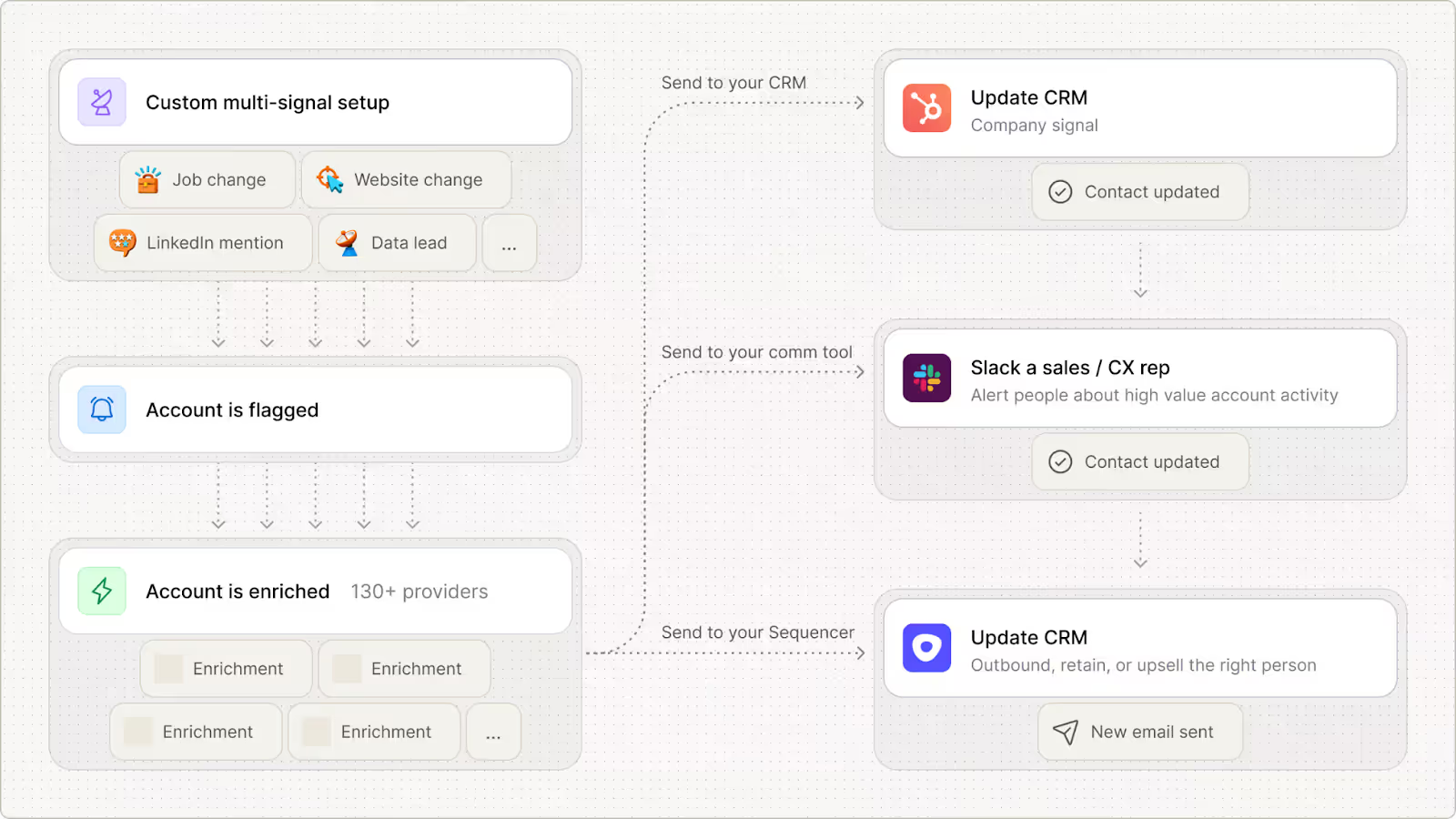
As a result, sales teams will achieve shorter cycles, higher reply rates, and outreach that feels timely and relevant as it’s now based on real-time prospect behavior and intent signals, not random schedules.
AI personalization at scale
One of the hardest parts of outbound isn’t finding qualified leads but reaching out in a way that feels personal and worthy of a response.
Writing a thoughtful opener for one prospect is easy. Writing a couple of hundred a day is impossible without help, and this is where AI-powered personalization steps in.
But it’s important to first lay a solid foundation before leveraging any tools to ensure truly meaningful outreach. Michel Lieben, Founder & CEO of ColdIQ, explains it like this:
“Most orgs build massive lead lists and then try to write copy that appeals to everyone. Appealing to everyone = appealing to no one. Instead, start with one ideal lead, write as if they’re the only person in your world, repeat with 10–20 more, uncover patterns, and only then scale with automation.”
The data and signals you’ve collected from the previous steps will only drive results if used correctly. Well, modern outreach platforms seamlessly integrate with your prospecting tools and plug those signals directly into campaigns the moment they come up.
For example, lemlist can auto-insert a dynamic opener pulled from Clay to craft a personalized email opening: “Congrats on the $15M raise — guessing your SDR team is about to double.” These same workflows will also generate personalized subject lines, value props, and CTAs, ensuring that each message delivers real value at every touchpoint.
For high-value accounts, reps can still add some human touches before hitting send, but the heavy lifting is now automated. Done right, this approach doubles reply rates while freeing sales teams to focus on conversations instead of manual research and copywriting.
Multi-touch outreach sequences
When it comes to effective outbound outreach, personalization is only half the battle. The other half is persistence, especially in B2B, where sales cycles can take months at a time.
Most prospects won’t reply to a single email for many different reasons, even if it’s perfectly written and potentially interesting. That’s why multi-touch, multi-channel sequences are a cornerstone of modern outbound.
The logic is quite simple: people respond differently depending on where you reach them. Some prospects and decision-makers prefer replying to emails, others are more open to starting a conversation on LinkedIn, and some might only engage after a quick call.
A strong sequence blends all these channels into one automated flow, where one action triggers the next, and each touchpoint is spaced at the most optimal time. Here’s a simple example of how that works in lemlist:
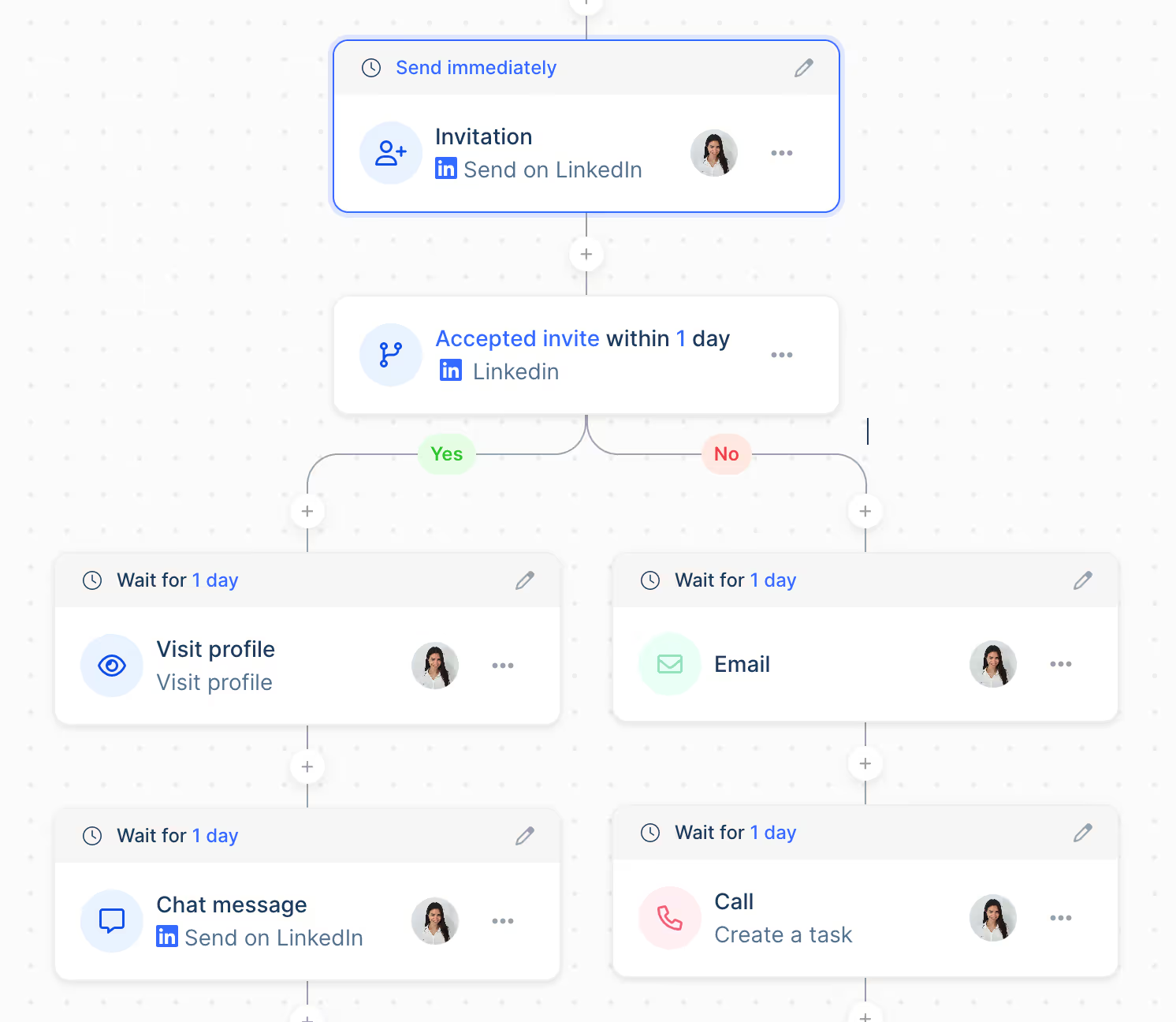
Many outreach platforms now offer multichannel capabilities under one roof, while others offer more specialized features for one specific channel, as in the case with Instantly AI (email) and Expandi (LinkedIn).
AI SDRs like Artisan go even further, acting as fully-fledged sales agents that join your team and handle much of the entire outbound lead generation process.
Whichever tech teams choose to work with, those that embrace this automated structure see dramatically higher engagement because they show up consistently, in the right places, with the right context.
Account-based sales
B2B outbound is uniquely challenging as it is, with sales cycles stretching over months and multiple stakeholders involved. In many cases, the best way to achieve success is with persistent, role-specific outreach that builds trust over time.
That’s precisely the logic behind account-based sales (ABS) — instead of treating leads as isolated names, you treat the account as the target and engage all the relevant decision-makers, influencers, and end-users.
No matter how well-crafted, the exact same pitch won’t resonate with all three. ABS solves this by mapping the buying roles within each account, and then crafting role-specific messaging aligned to their unique priorities.
Let’s take a fintech startup that wants to work with a Fortune 500 company. It will first research and identify the company’s entire buying committee, and then the CFO gets ROI-focused outreach, the RevOps VP hears about how to improve workflow efficiency, and IT leaders hear about key product features along with case studies.
As a result, each conversation is highly relevant yet consistent across the entire account.
Visual idea: would be great if we could create our own version of this to show how account-based prospecting/sales differs from traditional methods.
It requires more upfront work, but the payoff is significant — higher win rates and faster progression through the long sales cycles, especially useful for companies chasing big-ticket deals.
How to measure and improve your outbound lead generation
It’s virtually impossible to build an outbound system perfectly right from the very start. Instead, it needs continuous, data-driven refinement, especially in the early stages.
And even the best outbound lead generation strategies eventually lose their impact if you don’t measure what’s happening with your lead generation efforts, and make the necessary adjustments in time.
The most useful metrics fall into three categories:
- Prospecting accuracy → Reply rate is key here. If low, it usually means your ICP targeting is off or you’re missing enrichment context that makes outreach relevant.
- Outreach effectiveness → Booked meeting rate shows whether replies convert into meetings, or whether your pitch sparks curiosity, but value proposition needs tightening.
- Deliverability health → Open rates, bounce rates, and spam rates reflect whether your email infrastructure (domain setup and account warm-up) is holding up.
From there, optimization comes through structured A/B testing of subject lines, openers, and CTAs. After a couple of hundred, see what works and what doesn’t, and rotate the winners forward.
Just as important is feeding insights back into targeting: if job-change triggers outperform funding signals, adjust the enrichment rules to ensure the next list is even sharper.
Small tweaks here and there may result in 5–10% reply rate increases, and that adds up to massive pipeline and revenue gains over time.
What are outbound lead generation examples?
Theory is helpful, but it's just as important to see how outbound systems work in practice.
Here are two successful outbound lead generation examples from real companies, along with the strategies used and the results achieved:
AirOps: $3M in pipeline in 3 months
AirOps is an AI-powered SaaS platform that helps marketing and content teams grow traffic and revenue by turning search insights into clear actions.
Their inbound demand was already strong, but their outbound wasn't getting the results they expected, mostly because of static lists, one-off campaigns, and little visibility into performance.
To fix this, they partnered with ColdIQ to completely rebuild their outbound engine from scratch:
- ICP precision → exclusively targeted SaaS companies with 20-300 employees that have shown signs of strong SEO investment, all verified and enriched through Clay and LinkedIn signals.
- Multichannel execution → for outreach, we blended email with LinkedIn, and placed a strong emphasis on event-led campaigns (which ended up driving the highest meeting conversions), sequenced via Smartlead and CommonRoom.
- Constant iteration → we tested subject lines, CTAs, and follow-ups every week to improve the strategy for the maximum impact.
The results achieved were quite impressive:
- 50+ positive replies within just 1 week
- $3M in qualified pipeline within 3 months
- 2x revenue growth in 8 months
The key takeaways were that AirOps’ outbound started producing excellent results once the system became extremely precise (right 500 leads > random 5,000), cohesive (integrated data flow), and value-driven, while consistent small refinements compounded over time.
Design Pickle: 2x demos in 2 weeks
Design Pickle is a create services provider that specializes in graphic design, custom illustrations, presentation design, and video editing for fast-growth companies.
Initially, their growth relied heavily on paid media, whereas outbound efforts were manual, inconsistent, and delivering only around 10 demos per week, despite already having a decent tech stack
After partnering with ColdIQ, they shifted to a fully operationalized outbound system:
- Data enrichment and scoring → Clay tables tightened and automated lead qualification, so only accounts that perfectly matched Design Pickle's ICP entered outreach sequences.
- Sequencing and deliverability → Apollo used Clay's enriched data to personalize emails with AI, while maintaining a solid deliverability infrastructure to keep inbox placement strong.
- Pipeline visibility → HubSpot brought everything together in one for better visibility, and Vector de-anonymized website traffic to find and capture hidden intent.
The positive impact was immediate:
- 58 demos booked in just 14 days (≈29 per week, nearly 3x more than before)
- AE calendars maxed out — literally requiring them to increase team headcount
- Lower CAC, as outbound now replaced a substantial chunk of paid acquisition
The biggest takeaway was that Design Pickle’s outbound lead generation began to scale and produce better results once all their tools were connected into one GTM system rather than running in silos.
These are just a few successful outbound lead generation examples, but in reality, any company that uses the strategies and software mentioned in this guide can see real results in no time.
Companies can also work with expert agencies like ColdIQ to build an effective outbound system, just like in the case of AirOps and Design Pickle, which brings us to our next point.
Why choose a specialized agency for your outbound needs?
Running outbound in-house may sound easy until you actually try it: domains get burned, opportunities get missed, outreach doesn't spark people's interest, and sales reps spend hours on automation and infrastructure instead of selling.
Another solution is to partner with a specialized agency like ColdIQ that offers proven expertise in outbound lead generation services.
Rather than spending time and money on hiring and training SDRs to do prospecting, enrichment, deliverability monitoring, copywriting, and follow-ups, you simply outsource the entire lead gen process to a team that already knows the playbook inside out.
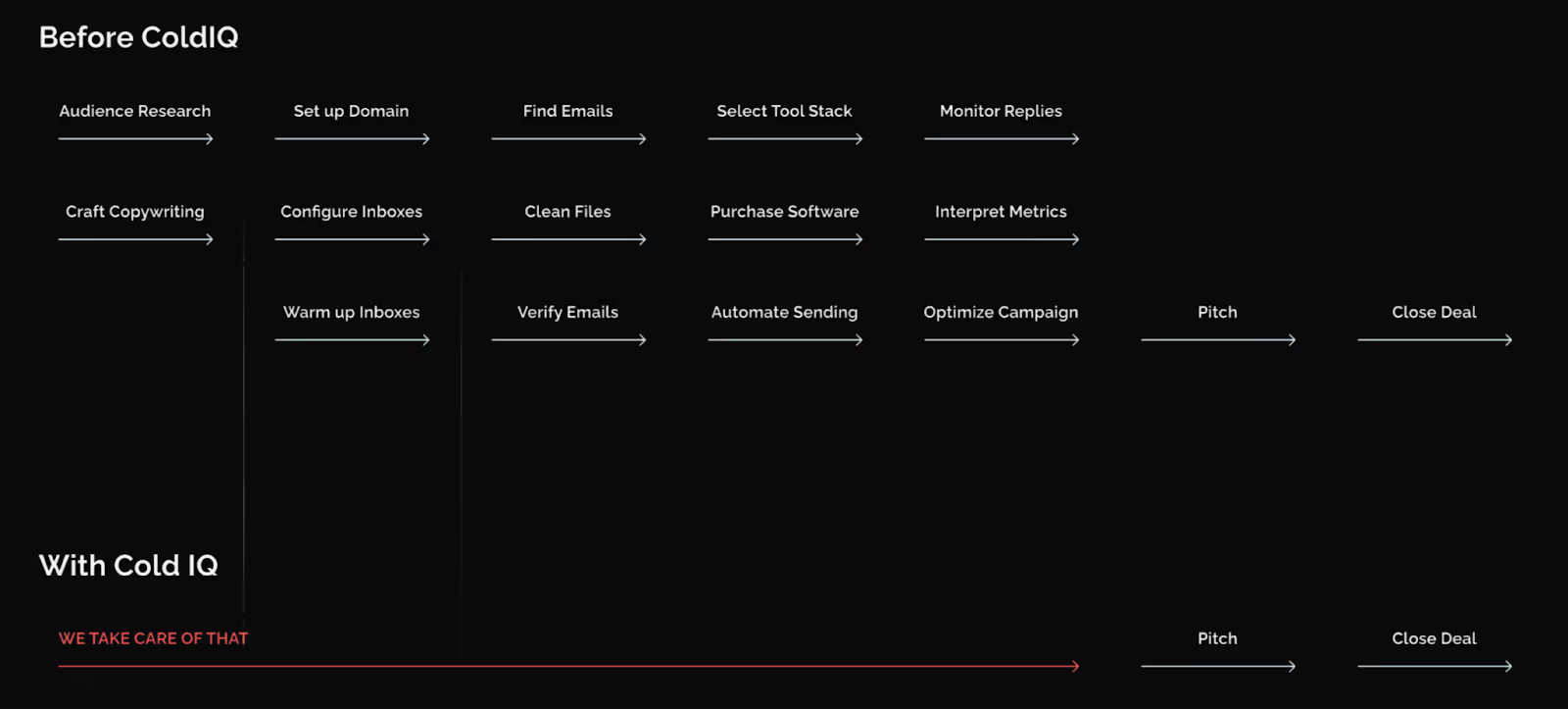
Here are the main things to look for in a partner:
- Proven track record with outbound campaigns
- Transparent reporting on replies, meetings, and pipeline
- A modern tool stack with workflows already dialed in
- Custom strategies tailored to each unique business
ColdIQ ticks all of these boxes, joining forces with your business as a strategic GTM partner.
With campaigns producing reply rates above 50%, we combine our technical expertise with proven execution strategies to build outbound engines that bring your business a steady flow of qualified leads.
Ramp-up time shrinks from quarters to weeks, you avoid the additional headcount, onboarding, and training costs, and all that’s left for your sales team is to make that final pitch and close the deal.
Getting started with outbound lead gen in 2025
Outbound lead generation works when the system is tight: clear ICPs, enriched data, personalized messaging, multi-touch sequences, and ongoing testing. Miss one piece, and results stall. Get them all right, and you’ve got a predictable pipeline that inbound alone can’t match.
That said, setting it up properly isn’t simple. Deliverability, automation, enrichment, and reply management each come with their own landmines. Outbound is still the most dependable channel for driving qualified leads at scale — but only if the system is built and maintained correctly.
If you’d rather shortcut the trial and error, consider bringing in a partner. Agencies like ColdIQ specialize in setting up and running outbound engines that deliver consistent meetings, so your sales team can focus on building long-term relationships and closing deals.
FAQ
Many teams send generic messages without personalization and ignore data quality. Poor timing and lack of follow-up also lower response rates significantly. Fixing these improves engagement and pipeline consistency.
Focus on precise ICP targeting and use automation for repetitive tasks like follow-ups. Prioritize high-potential leads to maximize impact without overwhelming your capacity.
How to maintain healthy email deliverability in outbound campaigns?
What are effective ways to nurture non-ready leads from outbound efforts?
Let's Get Started!
Schedule a 30-minute call with ColdIQ leadership to learn how our outbound strategy and sales tools help generate qualified leads and close deals.
.avif)
.svg)
.avif)
.avif)
.avif)
.avif)
.avif)
